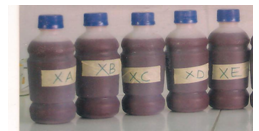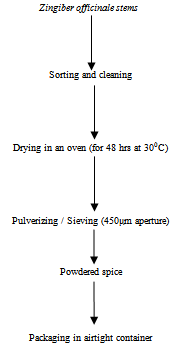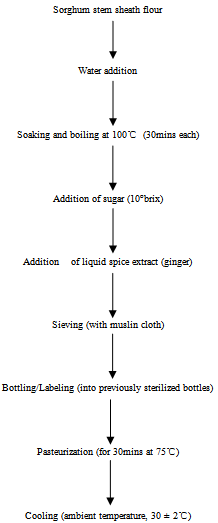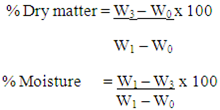-
Paper Information
- Next Paper
- Paper Submission
-
Journal Information
- About This Journal
- Editorial Board
- Current Issue
- Archive
- Author Guidelines
- Contact Us
International Journal of Food Science and Nutrition Engineering
p-ISSN: 2166-5168 e-ISSN: 2166-5192
2013; 3(3): 21-27
doi:10.5923/j.food.20130303.01
Nutritional Composition of a Non-Alcoholic Beverage Spiced with Zingiber officinale Extract Produced from Sorghum bicolor Stem Sheath
Oluwalana I. B.1, Adedeji T. O.2
1Department of Food Science and Technology, Federal University of Technology, P.M.B. 704, Akure, Nigeria
2Department of Food Science and Technology, Osun State Polytechnic, P.M.B. 301, Iree, Nigeria
Correspondence to: Oluwalana I. B., Department of Food Science and Technology, Federal University of Technology, P.M.B. 704, Akure, Nigeria.
| Email: |  |
Copyright © 2012 Scientific & Academic Publishing. All Rights Reserved.
The formulated beverage samples with ginger extract were analysed to determine its nutrient profile: proximate and mineral contents. Proximate analysis of the spiced stem sheath beverage revealed that the beverage is a nutrient dense commodity with health promoting substances with high level of protein and fat: the moisture content ranged between 87.890-88.360%, crude protein ranged between 0.092-0.052% and crude fat from 0.190-0.150% while pH and TTA were 7 and 4 respectively. The plain beverage sample had the least protein and fat content. High mineral contents were recorded for the spiced beverage samples: magnesium ranged between 145.00-220.200mg/100ml, sodium ranged between 25.200-26.580mg/100ml, potassium ranged between 23.025-30.950mg/100ml,calcium 50.000-50.045mg/100ml, iron 4.000-5.340mg/100ml, zinc 2.500-3.170mg/100ml, manganese 0.380-1.730 and copper 0.0605-0.071mg/100ml while the plain beverage sample had the least mineral content. The nutrient profile increased significantly at (p < 0.05) with the addition of ginger, the degree of enhancement was dependent on the concentration of the spice. The overall sensory evaluation revealed that acceptability was in order of 0.5% extract of ginger being the best preferred by the panellists.
Keywords: Ginger, Nutritional, Composition, Sorghum Bicolor, Stem, Sheath
Cite this paper: Oluwalana I. B., Adedeji T. O., Nutritional Composition of a Non-Alcoholic Beverage Spiced with Zingiber officinale Extract Produced from Sorghum bicolor Stem Sheath, International Journal of Food Science and Nutrition Engineering, Vol. 3 No. 3, 2013, pp. 21-27. doi: 10.5923/j.food.20130303.01.
Article Outline
1. Introduction
- Sorghum is an important staple food crop in African, South Asia and Central America, is the fifth major cereal crop in the world after wheat, rice, maize and barley[14]. It is also grown in the United States, Australia, and other developed nations for animal feed. Sorghum is most extensively cultivated in the drier Northern Guinea, Sudan Savannah and Greenland of African, Plains of India and the Great plains United State of America[10]. It has grown in India and China for almost 2000 years. It is a vastly complex genus, embracing hundreds of variants of different characteristics and adapted to different ecological riches and with a variety of economic uses. It resembles maize in its vegetative character but different in having narrow leaves and a waxy bloom covering the leaves and stem. It also has a well-developed root/stem which is twice as efficient as that of maize although its leaf area is only half that of maize[12]. Historically, sorghum has been used in West Africa to colour leather goods which include suitcases, shoes, baskets, hats and book covers. Traditionally, bundles of leaf sheaths are extracted in a laborious cottage–industry process. Other uses of sorghum include the production of industrial alcohol from the seeds, vegetable oil, broom-making, adhesives, waxes, sizing papers and cloth[15]. Sorghum bicolor are popularly used nationwide to prepare a gruel meal or pap. The gruel has been found to be highly nutritious (Olukemi and Olukemi, 2005). There is a huge potential benefit, both economic and health wise if this food crop is developed as a natural food colorant in Nigeria. The stem has been used in the preparation of local medicine to treat anaemia and other related blood ailment. It has been reported to be used as an anti-malarial and anthelminthic[24]. The Sorghum bicolor L. Moench stem is sweet to taste and is found to contain some sugar and minerals; this sugary nature makes it to be easily chewed in African and Asia and is used for manufacture of syrup[ . It is also used as colour additive in cooking meals and taken as beverages when steeped or boiled in water in many homes in Nigeria[4]. The use of local spices to control the activities of micro-organisms in food has been reported[7, 18]. Apart from antimicrobial activities, spices are believed to have medicinal value (especially in African settings) and have desirable determinative influences on the overall organoleptic analysis when used. In view of these, it is therefore deemed fit to analyse the Sorghum stem sheath beverage in combination with ginger for its nutritive value.
2. Materials and Methods
- Mature reddish-purple Sorghum bicolor L. Moench stem sheath locally known as poporo, ginger (Zingiber officinale) and food grade sucrose. Sorghum stem sheath in dry form and ginger were purchased from market in Osogbo, Osun State. The method described by[5] was adopted with some modifications. The sorghum stem sheath was dry cleaned and further dried in an air oven at 30℃ for 6 hrs for moisture uniformity. The dried samples were milled separately into flour using a coffee mill and sieved through 450μm aperture sieve. The flour samples were packed in air tight containers until utilized.The stem sheath flour was soaked for 30mins at ambient temperature before boiling for 30mins. The extract was then filtered with clean muslin cloth to obtain clear filtrate. The filtrate was sweetened with food grade sucrose to a brix level of 100. The sweetened beverage was then dispensed into previously sterilized bottles before pasteurization at 75℃ for 30mins. The beverage samples were then subjected to further investigations. The beverage samples were represented by plates 1 and 2.
 | Plate 1. Sorghum stem sheath drink with ginger (Zingiber officinale) extract |
 | Plate 2. Sorghum stem sheath drink without spice (control) |
2.1. Preparation of Liquid Extract of Ginger
- The method described by[1] was adopted with some modification. The dry crude extract of Zingiber officinale was weighed differently andprepared with distilled water at 0.5%, 1.0%, 1.5%, 2.0% and 2.5% concentration. Each mixture was pasteurized at 75℃ for 30minutes and the liquid extracts were kept in previously sterilized bottles and cooled at ambient temperature before storage in a refrigerator (8 ± 2℃) until used. The flowchart for the process is described in Figure 1.
 | Figure 1. Flow chart for production of crude spice extract from Zingiber officinale |
2.2. Beverage Formulation from the Stem Sheath Flour and the Spice Extract
- The most appropriate ratio of 1:30 (w/v) stem sheath flour to water was used for the beverage preparation. The filtrate obtained was mixed with the extracts of ginger (Zingiber officinale) at above concentrations. This implies a total of 6 samples including beverage without spice (control). The mixture was sweetened as described above before boiling for 30mins.The beverage samples were pasteurized as described above to obtain a ready to drink beverage. The flowchart for the process is described in Figure 2.
 | Figure 2. Flow chart for the production of spiced beverage samples from sorghum stem sheath flour |
2.3. Proximate Composition of the Stem Sheath Beverage
2.3.1. Determination of Crude Protein
- About 1g of the samples was weighed into micro Kjeldahl digestion flask and one tablet of Selenium catalyst was added .The mixture was digested on an electrothermal heater until clear solution was obtained. The flask was allowed to cool after which the solution was diluted with distilled water to 50ml and 5ml of this was transferred into the distillation apparatus, 5ml of 2% boric acid was pippeted into a 100ml conical flask (the receiver flask) and four drops of screened methyl red indicator were added. About 50% NaOH was continually added to the digested sample until the solution turned cloudy which indicated that the solution had become alkaline.Then distillation was carried out into the boric acid solution in the receiver flask with the delivery tube below the acid level. As the distillation was going on, the pink colour solution of the receiver flask turned blue indicating the presence of ammonia. Distillation was continued until the content of the flask was about 50ml after which the delivery of the condenser was rinsed with distilled water. The resulting solution in the conical flask was then titrated with 0.1M HCl[24].Calculation:

2.3.2. Determination of Dry Matter and Moisture Content
- About 2ml of each sample was measured into a previously weighed crucible, dried over water for sometimes. The crucible plus sample taken was transferred into the oven set at 100℃ to dry to a content weight for 24hour overnight. At the end of 24hours, the crucible plus sample was removed from the oven and transfer to the desiccator, cooled for ten minutes and weighed[8].The weight of empty crucible plus sample was W1while the weight of crucible plus oven dried sample was W3.
 % Moisture content = 100 - %Dm
% Moisture content = 100 - %Dm2.3.3. Crude Fat Determination
- This was carried out using the method of[8]. Clean and dried thimble was weighed(W1)and 5g oven dried sample was added and re-weighed (W2).Round bottom flask was filled with petroleum (ether40-60)℃ up to ¾ of the flask. Soxhlet extractor was fixed with a reflux condenser to adjust the heat sources so that the solvent boils gently, the samples were put inside the thimble and inserted into the soxhlet apparatus and extraction under reflux was carried out with petroleum ether for 6 hours. After the barrel of the extractor is empty, the condenser was removed and the thimble was removed, taken into the oven at 100℃ for 1 hour and later cooled in the dessicator and weighed again (W3).

2.3.4. PH Measurement
- The pH was measured using a PH meter, digital model EA513-055, ELE, England standardized with buffer solution of 4.0 and 7.0[8]. The glass electrode of pH meter was dipped in 30mls of the beverage sample measured into a curvette at ambient temperature and was allowed to stabilize for sometimes after which the reading was taken.
2.3.5. Titratable Acidity
- About 4 ml of the sample was measured into a 250ml conical flask and 200ml 0f carbon dioxide with distilled water added. The flask was allowed to stand in a water bath at 40℃ for 1hr. It was swirled occasionally to ensure complete mixing before filtration. Phenolphthalein was added after filtration and then titrated against 0.1m Na0H solution[8].The result was expressed as % lactic acid equivalent present in the beverage.

2.4. Determination of Mineral Contents
- The method described by[8] using atomic absorption spectrophotometer (AAS) Buck scientific East Norwalk, CT, USA was used for mineral contents determination. The minerals determined were potassium, sodium, calcium, iron, magnesium, copper, manganese, lead and zinc. While operating the AAS, all controls on the left front panel, right front panel and the pressure regulator were set at zero mark. Thereafter, required hollow cathode (HC) lamp corresponding to the required mineral and the holders in the lamp compartments was installed. On turning on the switch and utilizing the appropriate lamp current meters, the concentrations of the various metallic mineral elements were determined. The analysis was done in triplicates.
2.5. Sensory Evaluation
- The beverage samples were presented as coded samples to 10 semi -trained panellists according to the method reported by[17]. The panellists were asked to indicate their observations using a 9- point hedonic scale for taste, after taste, flavour/aroma, colour, consistency and overall acceptability. The coded samples were served in clean transparent bottles at room temperature (25℃). Samples presented to the panellist were at random and one at a time .The panelists were given enough water to rinse their mouths between each sample. Like extremely and dislikes extremely were ranked 9 and 1 respectively. Statistical analysis was carried out using Statistical Analysis Software (SAS, 1999) package (version 8.2 of SAS Institute, Inc.). The scores from the ratings were subjected to analysis of variance (ANOVA) and means were separated using Duncan multiple range test (Duncan, 1955) and the significance was accepted at p<0.05.
3. Result and Discussion
3.1. Proximate Composition, pH and TTA value of Sorghum Stem Sheath Beverage
- The proximate composition of sorghum stem sheath beverage is presented in Table 1. The moisture content of the beverages ranged from 87.890 to 88.360% significant (p < 0.05). The sample with the lowest moisture content was those spiced with 5% ginger. It was observed that all the spiced samples had higher moisture content than the control without spice. This implies that addition of spice had significant effect on the moisture content. A decreasing trend in the moisture content with increasing concentration of ginger with moisture content of (39.70%) in the samples was observed with the exception of the sample spiced with 0% ginger. High moisture content makes beverage suitable as a refreshing and quench-thirsting product which is characteristic of good beverage although is an indication of short shelf life. This is similar to the report given by[23].The moisture content of sobo drink (88.88) % was higher than that of sorghum stem sheath beverage (87.890- to 88.360) % while the moisture content of kunnu 84.90% was lower than that of the stem sheath beverage[6; 10] .Ginger spiced samples had higher protein content than the plain beverage. The protein content of ginger (12.60%) has contributed significantly at (p<0.05) to the increase in protein content of beverage.[12; 14]. Plain beverage had a protein content of 0.005% while a range of 0.092 to 0.052% was recorded for samples containing ginger extracts at varying concentrations, respectively. Though beverage is not a good source of protein but addition of ginger to the sorghum stem sheath beverage resulted in significant (p<0.05) increase in their protein level. The observation shows a progressive significant decrease in the protein content with increasing ginger concentration in the sample. This may be attributed to the effect of heat process involved in the extraction which might have destroyed some amino acids with consequent reduction in total nitrogen content of the resulting beverage[22]. However, the protein contents of the ginger spiced samples (0.092-0.052) % were found to be higher than that of the sobo drink (0.046) % produced from Hibiscus sabdarriffa calyxesGinger spiced samples had higher crude fat content than the plain beverage sample. The lipid content of ginger (18.20%) has contributed significantly at p<0.05 to the increase in fat content of beverage though the beverage is not a good source of fat[12; 14]). Plain beverage had a crude fat content of 0.009% while a range of 0.009 to 0.150% was recorded for samples containing ginger extracts at varying concentrations, respectively. The observation shows a progressive significant decrease in the fat content with increasing ginger concentration in the sample. This might be attributed to the effect of direct heat on fat soluble components of the beverage during the process of extraction[2]. The fat content of sobo drink (0.15) % compares favourably well with that reported for sorghum stem sheath (0.009-0.150) %[10]
|
|
|
3.2. Mineral Composition of the Non-alcoholic Beverage
- The mineral composition of sorghum stem sheath beverage is as presented in Table 2. Ginger spiced beverage samples significantly (p<0.05) had higher magnesium content than the unspiced beverage. A significant (p < 0.05) decreasing trend in the magnesium content with increasing concentration of ginger in the samples was observed. Control sample had the least magnesium content in the beverage indicating the advantage of spicing the beverage with ginger. Plain beverage (control) had a magnesium content of 145.04mg/100ml while a range of 220.20-175.60mg/100ml was recorded for samples containing ginger extracts at varying concentrations respectively. However, the magnesium content of kunnu 30.03mg/100ml was lower than that of the stem sheath beverage[6]. All ginger spiced samples had higher sodium content than the plain beverage. Plain beverage had a sodium content of 25.20mg/100ml while a range of 26.58- 25.00 mg/100ml was recorded for samples containing ginger extracts at varying concentrations respectively. The observation shows a progressive significant decrease in the sodium content with increasing concentration of ginger in the beverage. However, the sodium content of the sobo drink 5.90mg/100ml was found to be lower than that of the stem sheath beverage[19].Ginger spiced beverage samples significantly (p<0.05) had higher potassium content than the unspiced beverage. A decreasing trend in potassium content with increasing concentration of ginger in the samples was observed. Plain beverage had a potassium content of 23.02mg/100g while a range of 30.95-22.94mg/100g was recorded for samples containing ginger extracts at varying concentrations, respectively. The potassium content of kunnu 134.27mg/ 100ml was however higher than that of the stem sheath beverage[6]. Nevertheless, it could be seen from the information contained in Table 2 that addition of spice significantly enhanced the potassium content of the beverage samples.Ginger spiced samples had higher calcium content than the plain beverage. Plain beverage had a calcium content of 50.00mg/100ml while a range of 50.04-42.07 mg/100ml was recorded for samples containing ginger and alligator pepper extracts at varying concentrations respectively. However, the calcium content of kunnu 5.18mg/100ml and sobo drink 6.00mg/100ml were lower than that of the stem sheath beverage[6, 19]. The observation shows a progressive significant decrease in calcium content in the beverages with increasing concentration of ginger. Ginger spiced beverage samples significantly (p<0.05) had higher iron content than the unspiced beverage. A decreasing trend in iron content with increasing concentration of ginger in the samples was observed with the exception of the sample spiced with 0% ginger. Plain beverage had iron content of 4.00mg/100ml while a range of 5.34-4.55mg/100ml was recorded for samples containing ginger extracts at varying concentrations respectively. Addition of ginger significantly enhanced the iron content of the beverage samples when compared to the control. However, the iron content of kunnu 70.02mg/100ml was higher than that of the stem sheath beverage[6] while the iron content of the sobo drink 2.40mg/100ml was much lower than that of the stem sheath beverage[19].Ginger spiced samples had lower zinc content than the plain beverage. Plain beverage had a zinc content of 2.50mg/100ml while a range of 3.17-2.69mg/100ml was recorded for samples containing ginger extracts at varying concentrations respectively. The zinc content of kunnu 3.30mg/100ml and sobo drink 2.68mg/100ml were found to be similar to that of the stem sheath beverage[5]. The observation shows a progressive significant decrease in zinc content with increasing concentration of both spices in the beverage. A pronounced impact of the spice on the zinc content is noted with the zinc content of all spiced beverages compared with the control.Ginger spiced beverage samples significantly (p<0.05) had higher manganese content than the unspiced beverage. A decreasing trend in manganese content with increasing concentration of ginger in the samples was observed. Addition of ginger into the beverage which has contributed significantly to the enhancement in the manganese content of the beverage[12]). Plain beverage had manganese content of 0.38mg/100ml while a range of 1.73-1.20mg/100ml was recorded for samples containing ginger extracts at varying concentrations respectively. The manganese content of kunnu 1.05mg/100ml was found to be lower than the ginger spiced samples.Similar copper content was recorded for almost all the beverages. Plain beverage had a copper content of 0.060 mg/100ml while a range of 0.071-0.061mg/100ml was recorded for samples containing ginger extracts at varying concentrations, respectively. However, the copper content of kunnu 0.011mg/100ml was found to be lower than that of the sorghum stem sheath beverage.
4. Conclusions
- This study has drawn attention to the potential of sorghum stem sheath and local spices in formulating nutritious and health promoting non-alcoholic beverage for the consumption of the Nigerian populace. From the foregoing, it can be concluded that sorghum stem sheath is a promising rich plant material that could be used in the formulation of functional foods as evidenced in its nutritional profile recorded in this study. Protein, fat, minerals contents increased noticeably in all the spiced samples. The most abundant minerals in the sorghum stem sheath drink were magnesium followed by calcium, potassium, sodium, iron, manganese, copper and zinc. However, progressive decrease in the nutrient was observed with increasing concentration of the spices in the beverage which could be attributed to the dilution factor by other components in the spices. The result of this study reveals that nutritious and relatively shelf stable non-alcoholic beverage could be produced from sorghum stem sheath and local spices without the use of chemical preservatives.Sensory attributes of the beverage samplesThe sensory attributes of the formulated beverage samples are presented in Table 4. Beverage spiced with 0.5% ginger had the best ratings in all sensory attributes evaluated. Unspiced beverage (control) had the least ratings in all the sensory attributes indicating the potential of the spices in producing acceptable beverage from sorghum stem sheath. Varying the concentration of ginger in the beverage did not result in significant (p<0.05) changes in almost all the studied sensory attributes.
 Abstract
Abstract Reference
Reference Full-Text PDF
Full-Text PDF Full-text HTML
Full-text HTML

